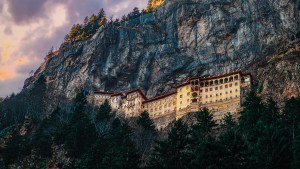Cappadocia, Turkey, a region famous for its otherworldly landscapes and unique rock formations, is also home to a labyrinth of ancient underground cities that once served as sanctuaries for early Christians during times of persecution. Among these subterranean wonders, Derinkuyu, Kaymakli, and Matiate stand out for their historical significance and intricate architecture.
Derinkuyu: A colossal underground refuge
Derinkuyu, the largest excavated underground city in Turkey, extends to a depth of approximately 85 meters (280 feet) and could house up to 20,000 people, along with their livestock and supplies.
Rediscovered in 1963, the multi-level city has numerous amenities including wine and oil presses, stables, cellars, storerooms, chapels, and other liturgical spaces. Unique to Derinkuyu is a large room with a barrel-vaulted ceiling, believed to have been used as a religious school – a space where catechumens would be able to get proper formation while hiding from hostile authorities.
A series of vertical staircases connect the third and fourth levels to another church on the fifth level, underscoring the city’s role as a spiritual haven and refuge for Christians fleeing persecution.

Kaymakli: A connected harbor
Kaymakli, connected to Derinkuyu by a 5-mile tunnel, is another remarkable underground city. This complex is known for its extensive network of tunnels and rooms that were used for both residential and religious purposes.
The inhabitants of Kaymakli expanded their living spaces vertically, creating a multi-layered community that could be sealed off with large rolling stone doors, ensuring protection from invaders. During times of religious strife, Kaymakli served as an important refuge for Christian communities, protecting their faith and way of life.

Matiate: The new discovery
Although less well known, Matiate adds another layer to Cappadocia’s underground cities. Recent excavations have revealed its importance as a refuge and place of worship for early Christians.
Like Derinkuyu and Kaymakli, Matiate’s intricate design and strategic construction offered its inhabitants safety and a sense of community during times of persecution, underscoring the vital role these underground sanctuaries played in the survival of the early Christian faith.
A story of survival
The origins of these underground cities date back to the 8th-7th centuries BC, first carved out by the Phrygians. Over time, especially during the Byzantine era, these underground havens were expanded and fortified to protect against Arab-Muslim invasions.
The Christian inhabitants continued to use these cities as refuges during the Mongol invasions of the 14th century and later during periods of Ottoman rule, when Christians sought refuge from Turkish Muslim rulers.

Modern rediscovery and preservation
The underground cities of Cappadocia were largely forgotten until their rediscovery in the 20th century. Derinkuyu, uncovered in 1963 when a local resident found a hidden room behind a wall, soon became a focus of archaeological interest. Today, about half of Derinkuyu is open to visitors, offering a unique journey through history.
For modern travelers, exploring Derinkuyu, Kaymakli, and Matiate is more than just visiting ancient ruins. It is a pilgrimage into the heart of Christian resilience and ingenuity, set against the stunning backdrop of Cappadocia’s geological wonders.
Whether you are a history enthusiast, a spiritual seeker, or a Christian adventurer, these underground cities offer an unforgettable experience that highlights the indomitable spirit of Christian communities who found refuge and solace in these subterranean sanctuaries during tumultuous times.



